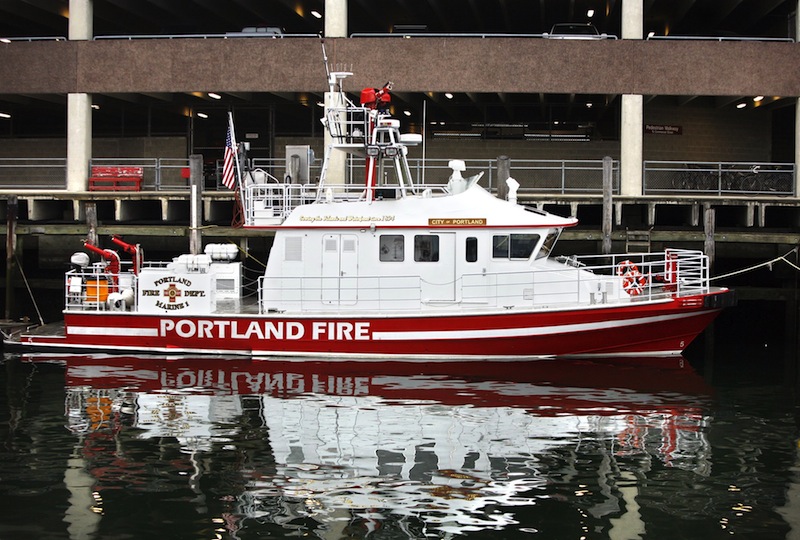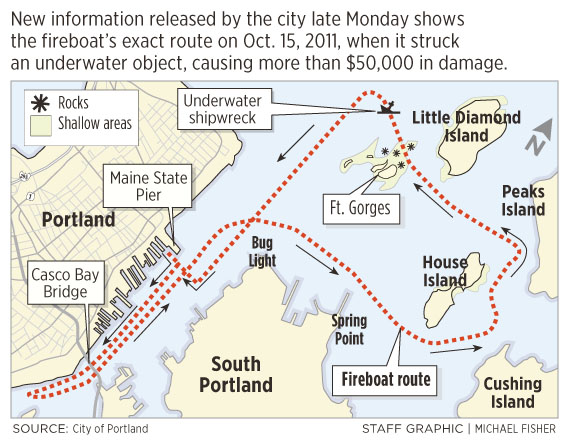PORTLAND — The city’s fireboat was traveling at 14 knots through an area of Casco Bay with known hazards when it hit an underwater object near Fort Gorges in 2011, sustaining more than $50,000 worth of damage.
The City of Portland IV passed through the area with shallow ledges and a marked shipwreck at roughly 16 mph about two hours before low tide on the evening of Oct. 15, 2011, the city told the Coast Guard in its report on the accident.
The report, compiled by deputy fire chief David Pendleton, was released in response to a Freedom of Access request filed by the Portland Press Herald after city officials refused to disclose details about the accident.
Fire Chief Fred LaMontagne, who retired last spring, investigated the incident, but the city will not release that document.
The city’s report to the Coast Guard was filed a week after the accident, even though Coast Guard guidelines require immediate reporting of marine accidents.
Lt. Nick Barrow, spokesman for the Coast Guard in South Portland, said Monday that he could not comment on the city’s or the Coast Guard’s investigation.
He did address general navigation practices, saying there is no enforceable speed limit outside the “No Wake” zone in Portland Harbor, but mariners should use common sense and travel at safe speeds. The shipwreck is marked on navigational charts.
“I believe its location is well known,” Barrow said.
City officials have refused to say specifically what the fireboat hit, describing it only as a “marked hazard.”
They also won’t say how fast the boat was going at the time of the accident or what the two-member crew and 12 civilian passengers were doing when the accident occurred.
Fire Capt. Christopher Goodall and firefighter Joseph Murphy were suspended for their roles in the accident.
They successfully appealed their suspensions with the help of their union, Local 740 of the International Association of Firefighters. An arbitrator reduced their suspensions and told the city to pay more than $1,100 in back wages to the men.
Goodall, who invited friends and family members aboard and was responsible as the boat’s lookout, received $878 in back wages.
The arbitrator found that the fireboat should not have left the marked “Destroyer Channel,” and when it did leave the channel, the pilot — Murphy — should have navigated around “marked hazards in a safe manner.”
The captain/engineer — Goodall — should have alerted the pilot to the marked hazards, but failed to do so and should have been more aware of his surroundings, the arbitrator found.
According to the city’s accident report filed with the Coast Guard, the fireboat left the Maine State Pier at 5 p.m. on Oct. 15, 2011, shortly before sunset, on what the city describes as a training run.
The boat went up the Fore River and under the Casco Bay Bridge. It turned around and then passed Bug Light and Spring Point Ledge Lighthouse in South Portland, before heading to Peaks Island.
After passing Peaks Island at 5 knots, the 65-foot-long, 38-ton fireboat turned toward Fort Gorges and accelerated to 14 knots – roughly 16 mph – when it entered a shallow area between Fort Gorges and Little Diamond Island around 5:55 p.m.
Shortly after entering the area, the boat hit an object. The port shaft, strut prop and rudder were damaged.
Data from the fireboat’s instruments show that the boat, which draws 4 feet 2 inches of water, passed directly over the shipwreck.
After passing over the wreck, in about 8.9 feet of water, the fireboat slowed to 7 knots before returning to the harbor under its own power. It reached the Maine State Pier at 6:18 p.m.
According to a brief handwritten narrative in the accident report by Pendleton, the deputy fire chief, the crew stopped making headway after hitting the object, made sure the vessel was not taking on water and ensured that none of the 12 passengers was injured.
Pendleton wrote that the boat hit a “submerged object” and that the accident was a result of “poor choice of course.”
Also, he wrote, “pilot inattention to navigational aids contributed to the accident.”
Barrow, the Coast Guard lieutenant, said the channel between Fort Gorges and Little Diamond Island is heavily traveled. The shipwreck is outside the federally marked navigation channel that is considered a safe passage.
Barrow said it is not uncommon or illegal for mariners to go outside the marked channel, but they must use caution and consider the tide and their vessel’s draft.
“It all comes back to mariners practicing good seamanship,” he said.
Peter Bryant, a retired merchant mariner who is a licensed pilot in Portland Harbor, was surprised to hear how fast the fireboat was going in an area of marked obstructions so close to low tide.
“Oh my God,” he said. “He was going way too fast. He was going as if he was in the channel.”
Bryant said the information about the route of the fireboat that day makes him skeptical about the city’s claim that the two firefighters and 12 civilians were on a training run.
“They weren’t on a training run,” he said. “They were taking their friends on a tour of the harbor.”
Capt. Harold Cushing Jr. owns and operates House Island Tours, which takes visitors to House Island and Fort Scammel during the summer. He has been a licensed captain since 1967.
“The shipwreck is quite well known” to mariners, he said after being told that the fireboat passed through that area. “I avoid that area as best as possible because of the wreck. … It’s not a friendly area to tour. It’s like a ship graveyard out there.”
Cushing said he is surprised that the fireboat was traveling at 14 knots through the area.
“They were clipping right along,” he said. “Going 14 knots with a bigger boat, you have to pay attention because you can run over things real fast.”
Cushing, who delivers mail and freight to Cushing Island, said his mail boat, the St. Croix, goes no faster than 10 knots on mail runs. His other boat averages 7 knots.
Phineas Sprague, a licensed captain who owns Portland Yacht Services, said the public should cut the fire department some slack because many boats have hit the shipwreck or run aground there.
Sprague said many lobstermen fish around the wreck. Lobster buoys on the surface can give a mariner the impression that the area is deep and safe to use.
“Their mistake was (the firefighters) should not have been in that area,” Sprague said.
It was the second time that the $3.2 million fireboat was damaged in Casco Bay.
In November 2009, the vessel hit a ledge in Whitehead Passage, between Peaks and Cushing islands. The repair bill was $90,000.
Staff Writer Dennis Hoey contributed to this report.
Staff Writer Randy Billings can be contacted at 791-6346 or at:
rbillings@pressherald.com
Twitter: @randybillings
Send questions/comments to the editors.




